Influence of the Parameters of Used Biochar on the Dark Fermentation Process
Abstract
:1. Introduction
2. Materials and Methods
2.1. Materials
2.2. Biochar Production
2.3. Physical and Chemical Analysis
2.4. Methodology of Hydrogen and Biogas Efficiency Research
3. Results and Discussion
3.1. Inoculum
3.2. Biochar Production and Analysis
3.3. Hydrogen and Biogas Efficiency
4. Conclusions
Author Contributions
Funding
Data Availability Statement
Conflicts of Interest
References
- Czekała, W. Solid Fraction of Digestate from Biogas Plant as a Material for Pellets Production. Energies 2021, 14, 5034. [Google Scholar] [CrossRef]
- Selvakumar, P.; Adane, A.A.; Zelalem, T.; Hunegnaw, B.M.; Karthik, V.; Kavitha, S.; Jayakumar, M.; Karmegam, N.; Govarthanan, M.; Kim, W. Optimization of binary acids pretreatment of corncob biomass for enhanced recovery of cellulose to produce bioethanol. Fuel 2022, 321, 124060. [Google Scholar] [CrossRef]
- Czekała, W.; Bartnikowska, S.; Dach, J.; Janczak, D.; Smurzyńska, A.; Kozłowski, K.; Bugała, A.; Lewicki, A.; Cieślik, M.; Typańska, D.; et al. The energy value and economic efficiency of solid biofuels produced from digestate and sawdust. Energy 2018, 159, 1118–1122. [Google Scholar] [CrossRef]
- Guo, X.M.; Trably, E.; Latrille, E.; Carrère, H.; Steyer, J.P. Hydrogen production from agricultural waste by dark fermentation: A review. Int. J. Hydrogen Energy 2010, 35, 10660–10673. [Google Scholar] [CrossRef]
- Rahman, S.N.A.; Masdar, M.S.; Rosli, M.I.; Majlan, E.H.; Husaini, T.; Kamarudin, S.K.; Daud, W.R.W. Overview biohydrogen technologies and application in fuel cell technology. Renew. Sustain. Energy Rev. 2016, 66, 137–162. [Google Scholar] [CrossRef]
- Alves, H.J.; Bley Junior, C.; Niklevicz, R.R.; Frigo, E.P.; Frigo, M.S.; Coimbra-Araújo, C.H. Overview of hydrogen production technologies from biogas and the applications in fuel cells. Int. J. Hydrogen Energy 2013, 38, 5215–5225. [Google Scholar] [CrossRef]
- Kotay, S.M.; Das, D. Biohydrogen as a renewable energy resource—Prospects and potentials. Int. J. Hydrogen Energy 2008, 33, 258–263. [Google Scholar]
- Balat, M. Potential importance of hydrogen as a future solution to environmental and transportation problems. Int. J. Hydrogen Energy 2008, 33, 4013–4029. [Google Scholar] [CrossRef]
- Hassen Sellami, M.; Loudiyi, K. Electrolytes behavior during hydrogen production by solar energy. Renew. Sustain. Energy Rev. 2017, 70, 1331–1335. [Google Scholar] [CrossRef]
- Ghimire, A.; Frunzo, L.; Pirozzi, F.; Trably, E.; Escudie, R.; Lens, P.N.L.; Esposito, G. A review on dark fermentative biohydrogen production from organic biomass: Process parameters and use of by-products. Appl. Energy 2015, 144, 73–95. [Google Scholar] [CrossRef]
- Kanwal, F.; Torriero, A.A.J. Biohydrogen—A Green Fuel for Sustainable Energy Solutions. Energies 2022, 15, 7783. [Google Scholar] [CrossRef]
- Fagbohungbe, M.O.; Herbert, B.M.J.; Hurst, L.; Ibeto, C.N.; Li, H.; Usmani, S.Q.; Semple, K.T. The challenges of anaerobic digestion and the role of biochar in optimizing anaerobic digestion. Waste Manag. 2017, 61, 236–249. [Google Scholar] [CrossRef]
- Yadav, K.; Jagadevan, S. Example, Influence of Process Parameters on Synthesis of Biochar by Pyrolysis of Biomass: An Alternative Source of Energy. In Recent Advances in Pyrolyvsis, 2nd ed.; Al-Haj Ibrahim, H., Ed.; IntechOpen: London, UK, 2020. [Google Scholar] [CrossRef]
- Wu, G.; Tham, P.E.; Chew, K.W.; Munawaroh, H.S.H.; Tan, I.S.; Wan-Mohtar, W.A.A.Q.I.; Sriariyanun, M.; Show, P.L. Net zero emission in circular bioeconomy from microalgae biochar production: A renewed possibility. Bioresour. Technol. 2023, 388, 129748. [Google Scholar] [CrossRef] [PubMed]
- Lewandowski, W.M.; Ryms, M.; Meler, P. Termiczno-chemiczna piroliza do biopaliw ciekłych i gazowych, jako metoda podnoszenia sprawności konwersji energii biomasy. Nafta-Gaz 2010, 8, 675–680. [Google Scholar]
- Luo, C.; Lü, F.; Shao, L.; He, P. Application of eco-compatigle biochar in anaerobic digestion to relieve acid stress and promote the selective colonization of functional microbes. Water Res. 2015, 68, 710–718. [Google Scholar] [CrossRef]
- Mumme, J.; Srocke, F.; Heeg, K.; Werner, M. Use of biochars in anaerobic digestion. Bioresource Technology 2014, 151, 189–197. [Google Scholar] [CrossRef] [PubMed]
- Sun, Z.; Wang, X.; Wu, Y.; Du, W.; Li, H.; Zhang, P. Effect of sludge biochar on methane production from anaerobic granular sludge. J. Water Process Eng. 2023, 56, 104410. [Google Scholar] [CrossRef]
- Xu, S.; Bu, J.; Li, C.; Tiong, Y.W.; Sharma, P.; Liu, K.; Jin, C.; Ma, C.; Tong, Y.W. Biochar enhanced methane yield on anaerobic digestion of shell waste and the synergistic effects of anaerobic co-digestion of shell and food waste. Fuel 2024, 357, 129933. [Google Scholar] [CrossRef]
- Czekała, W.; Jasiński, T.; Grzelak, M.; Witaszek, K.; Dach, J. Biogas Plant Operation: Digestate as the Valuable Product. Energies 2022, 15, 8275. [Google Scholar] [CrossRef]
- Lehman, J.; Joseph, S. Biochar for Environmental Management: Science and Technology; Earthscan: London, UK, 2009. [Google Scholar]
- Verheijen, F.G.A.; Jeffery, S.; Bastos, A.C.; van der Velde, M.; Diafas, I. Biochar Application to Soils—A Critical Scientific Review of Effects on Soil Properties, Process and Functions; EUR 24099 EN; European Commission: Brussels, Belgium, 2010.
- Ahmad, M.; Rajapaksha, A.U.; Lim, J.E.; Zhang, M.; Bolan, D.M.; Vithanage, M.; Lee, S.S.; Ok, S.Y. Biochar as a sorbent for contaminant management in soil and water: A review. Chemosphere 2014, 99, 19–33. [Google Scholar] [CrossRef] [PubMed]
- Mohan, D.; Sarswat, A.; Ok, S.Y.; Pittman, C.U., Jr. Organic and inorganic contaminants removal from water with biochar, a renewable, low cost and sustainable adsorbent—A critical review. Bioresour. Technol. 2014, 160, 191–202. [Google Scholar] [CrossRef] [PubMed]
- Steiner, C.; Das, K.C.; Melear, N.; Lakly, D. Reducing nitrogen loss during poultry litter composting using biochar. J. Environ. Qual. 2010, 39, 1236–1242. [Google Scholar] [CrossRef]
- Deublein, D.; Steinhauser, A. Biogas from Waste and Renewable Resources; Wiley-VCH Verlag GmbH& Co. KGaA: Weinheim, Germany, 2008. [Google Scholar]
- Kaltschmitt, M.; Hartmann, H. Energie aus Biomasse—Grundlagen, Techniken und Verfahren; Springer: Berlin/Heidelberg, Germany; New York, NY, USA, 2001. [Google Scholar]
- Angelidaki, I.; Ahring, B.K. Thermophilic anaerobic digestion of livestock waste: Effect of ammonia. Appl. Microbiol. Biotechnol. 1993, 38, 560–564. [Google Scholar] [CrossRef]
- Hashimoto, A.G. Ammonia inhibition of methanogenesis from cattle wastes. Agric. Wastes 1986, 17, 241–261. [Google Scholar] [CrossRef]
- Jarrell, K.F.; Saulnier, M.; Ley, A. Inhibition of methanogenesis in pure cultures by ammonia, fatty acids, and heavy metals, and protection against heavy metal toxicity by sewage sludge. Can. J. Microbiol. 1987, 33, 551–555. [Google Scholar] [CrossRef] [PubMed]
- Parkin, G.F.; Lynch, N.A.; Kuo, W.; Van Keuren, E.L.; Bhattacharya, S.K. Interaction between sulfate reducers and methanogens fed acetate and propionate. Res. J. Water Pollut. Control Fed. 1990, 62, 780–788. [Google Scholar]
- Nie, W.; He, S.; Lin, Y.; Cheng, J.J.; Yang, C. Functional biochar in enhanced anaerobic digestion: Synthesis, performances, and mechanisms. Sci. Total Environ. 2024, 906, 167681. [Google Scholar] [CrossRef]
- Sanchez-Monedero, M.A.; Cayuela, M.L.; Roig, A.; Jindo, K.; Mondini, C.; Bolan, N. Role of biochar as an additive in organic waste composting. Bioresour. Technol. 2018, 247, 1155–1164. [Google Scholar] [CrossRef]
- Pan, J.; Ma, J.; Zhai, L.; Luo, T.; Mei, Z.; Liu, H. Achievements of biochar application for enhanced anaerobic digestion: A review. Bioresour. Technol. 2019, 292, 122058. [Google Scholar] [CrossRef]
- Świechowski, K.; Hnat, M.; Stępień, P.; Stegenta-Dąbrowska, S.; Kugler, S.; Koziel, J.A.; Białowiec, A. Waste to Energy: Solid Fuel Production from Biogas Plant Digestate and Sewage Sludge by Torrefaction-Process Kinetics, Fuel Properties, and Energy Balance. Energies 2020, 13, 3161. [Google Scholar] [CrossRef]
- Polish Standard PN-EN 14346:2011; Waste Characteristics. Calculation of Dry Mass on the Basis of Dry Residue or Water Content. Polski Komitet Normalizacji: Miar i Jakości, Poland, 2011.
- Polish Standard PN-EN 15169:2011; Waste Characteristics. Content of Organic Matter. Polski Komitet Normalizacji: Miar i Jakości, Poland, 2011.
- Polish Standard PN-Z-15008-04:1993; Municipal Solid Waste. Combustible and Non-Combustible Content. Polski Komitet Normalizacji: Miar i Jakości, Poland, 1993.
- Cieślik, M.; Dach, J.; Lewicki, A.; Smurzyńska, A.; Janczak, D.; Pawlicka-Kaczorowska, J.; Boniecki, P.; Cyplik, P. Methane fermentation of the maize straw silage under meso- and thermophilic conditions. Energy 2016, 115, 1495–1502. [Google Scholar] [CrossRef]
- Dach, J.; Boniecki, P.; Przybył, J.; Janczak, D.; Lewicki, A.; Czekała, W.; Witaszek, K.; Rodriguez Carmona, P.C.; Cieślik, M. Energetic efficiency analysis of the agricultural biogas plant in 250 kW(e) experimental installation. Energy 2014, 69, 34–38. [Google Scholar] [CrossRef]
- Kozlowski, K.; Dach, J.; Lewicki, A.; Malińska, K.; Paulino do Carmo, I.E.; Czekała, W. Potential of biogas production from animal manure in Poland. Arch. Environ. Prot. 2019, 45, 99–108. [Google Scholar] [CrossRef]
- Ajeng, A.A.; Abdullah, R.; Ling, T.C.; Ismail, S.; Lau, B.F.; Ong, H.C.; Chew, K.W.; Show, P.L.; Chang, J.S. Bioformulation of biochar as a potential inoculant carrier for sustainable agriculture. Environ. Technol. Innov. 2020, 20, 101168. [Google Scholar] [CrossRef]
- Gan, Y.Y.; Ong, H.C.; Chen, W.H.; Sheen, H.K.; Chang, J.S.; Chong, C.T.; Ling, T.C. Microwave-assisted wet torrefaction of microalgae under various acids for coproduction of biochar and sugar. J. Clean. Prod. 2020, 253, 119944. [Google Scholar] [CrossRef]
- Bagreev, A.; Bandosz, T.J.; Locke, D.C. Pore structure and surface chemistry of adsorbents obtained by pyrolysis of sewage sludge-derived fertilizer. Carbon 2001, 39, 1971–1979. [Google Scholar] [CrossRef]
- Pelaez-Samaniego, M.R.; Smith, M.W.; Zhao, Q.; Garcia-Perez, T.; Frear, C.; GarciaPerez, M. Charcoal from anaerobically digested dairy fiber for removal of hydrogen sulfide within biogas. Waste Manag. 2018, 76, 374–382. [Google Scholar] [CrossRef] [PubMed]
- Xu, X.; Cao, X.; Zhao, L.; Sun, T. Comparison of sewage sludge- and pig manurederived biochars for hydrogen sulfide removal. Chemosphere 2014, 111, 296–303. [Google Scholar] [CrossRef] [PubMed]
- Bu, J.; Wei, H.L.; Wang, Y.T.; Cheng, J.R.; Zhu, M.J. Biochar boosts dark fermentative H2 production from sugarcane bagasse by selective enrichment/colonization of functional bacteria and enhancing extracellular electron transfer. Water Res. 2021, 202, 117440. [Google Scholar] [CrossRef]
- Abukari, A.; Kaba, J.S.; Dawoe, E.; Abunyewa, A.A. A comprehensive review of the effects of biochar on soil physicochemical properties and crop productivity. Waste Dispos. Sustain. Energy 2022, 4, 343–359. [Google Scholar] [CrossRef]
- Dong, L.; Zhenhong, Y.; Yongming, S.; Xiaoying, K.; Yu, Z. Hydrogen production characteristics of the organic fraction of municipal solid wastes by anaerobic mixedculture fermentation. Int. J. Hydrogen Energy 2009, 34, 812–820. [Google Scholar] [CrossRef]
- Wang, X.; Zhao, Y. A bench scale study of fermentative hydrogen and methane production from food waste in integrated two-stage process. Int. J. Hydrogen Energy 2009, 34, 245–254. [Google Scholar] [CrossRef]
- Zong, W.; Yu, R.; Zhang, P.; Fan, M.; Zhou, Z. Efficient hydrogen gas production from cassava and food waste by a two-step process of dark fermentation and photo-fermentation. Biomass Bioenergy 2009, 33, 1458–1463. [Google Scholar] [CrossRef]
- Kim, J.K.; Nhat, L.; Chun, Y.N.; Kim, S.W. Hydrogen production conditions from food waste by dark fermentation with Clostridium beijerincki KCTC 1785. Biotechnol. Bioprocess 2008, 13, 499–504. [Google Scholar] [CrossRef]
- Du, J.; Xu, P.P.; Ren, H.Y.; Cao, G.L.; Xie, G.J.; Ren, N.Q.; Liu, B.F. Improved sequential production of hydrogen and caproate by addition of biochar prepared from cornstalk residues. Bioresour. Technol. 2023, 387, 129702. [Google Scholar] [CrossRef] [PubMed]
- Valdez-Vazquez, I.; Rios-Leal, E.; Esparza-García, F.; Cecchi, F.; Poggi-Varaldo, H. Semi-continuous solid substrate anaerobic reactors for H2 production from organic waste: Mesophilic versus thermophilic regime. Int. J. Hydrogen Energy 2005, 30, 1383–1391. [Google Scholar] [CrossRef]
- Hai, A.; Bharath, G.; Patah, M.F.A.; Daud, W.M.A.W.; Rambabu, K.; Show, P.L.; Banat, F. Machine learning models for the prediction of total yield and specific surface area of biochar derived from agricultural biomass by pyrolysis. Environ. Technol. Innov. 2023, 30, 103071. [Google Scholar] [CrossRef]
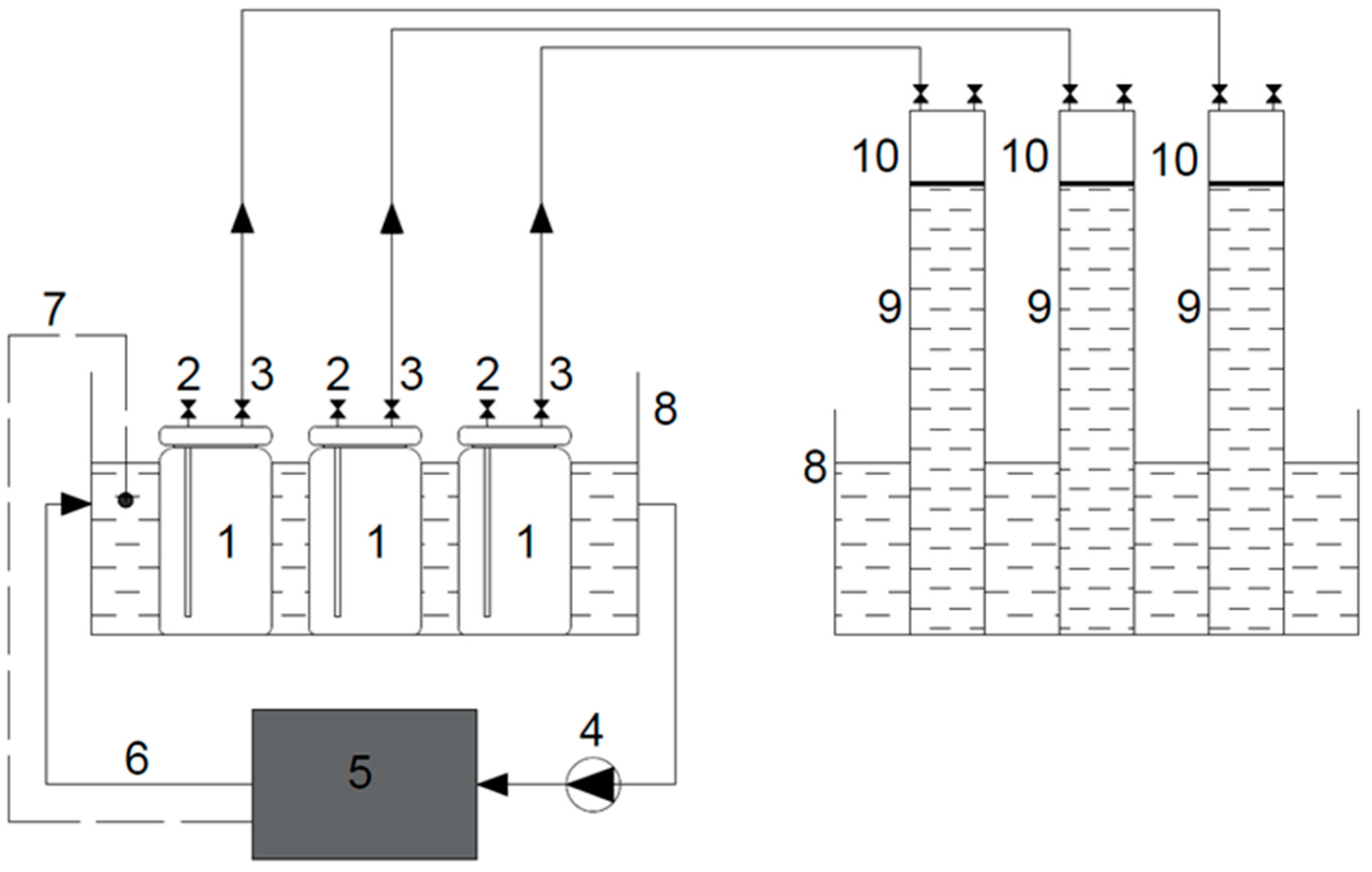
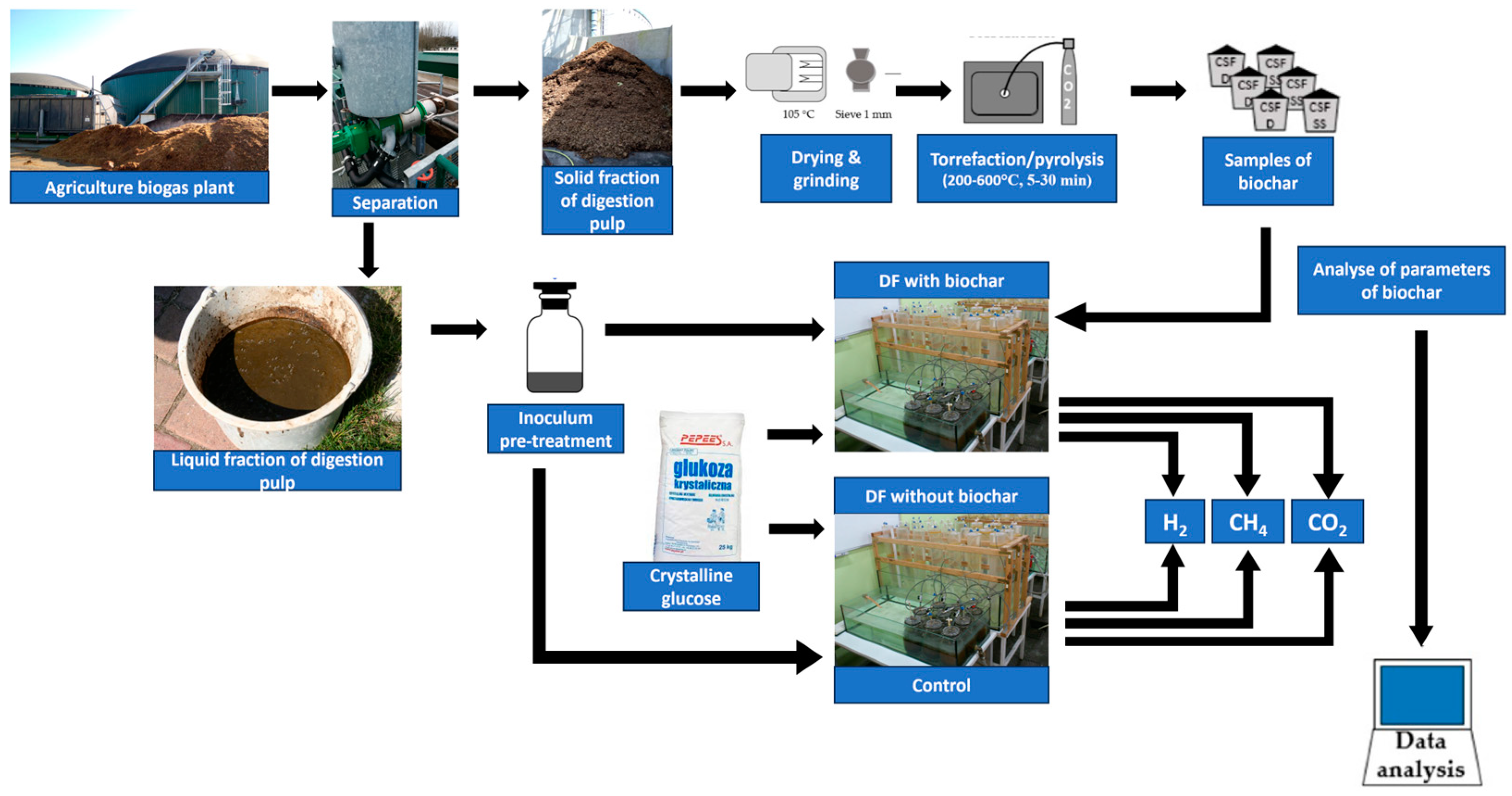
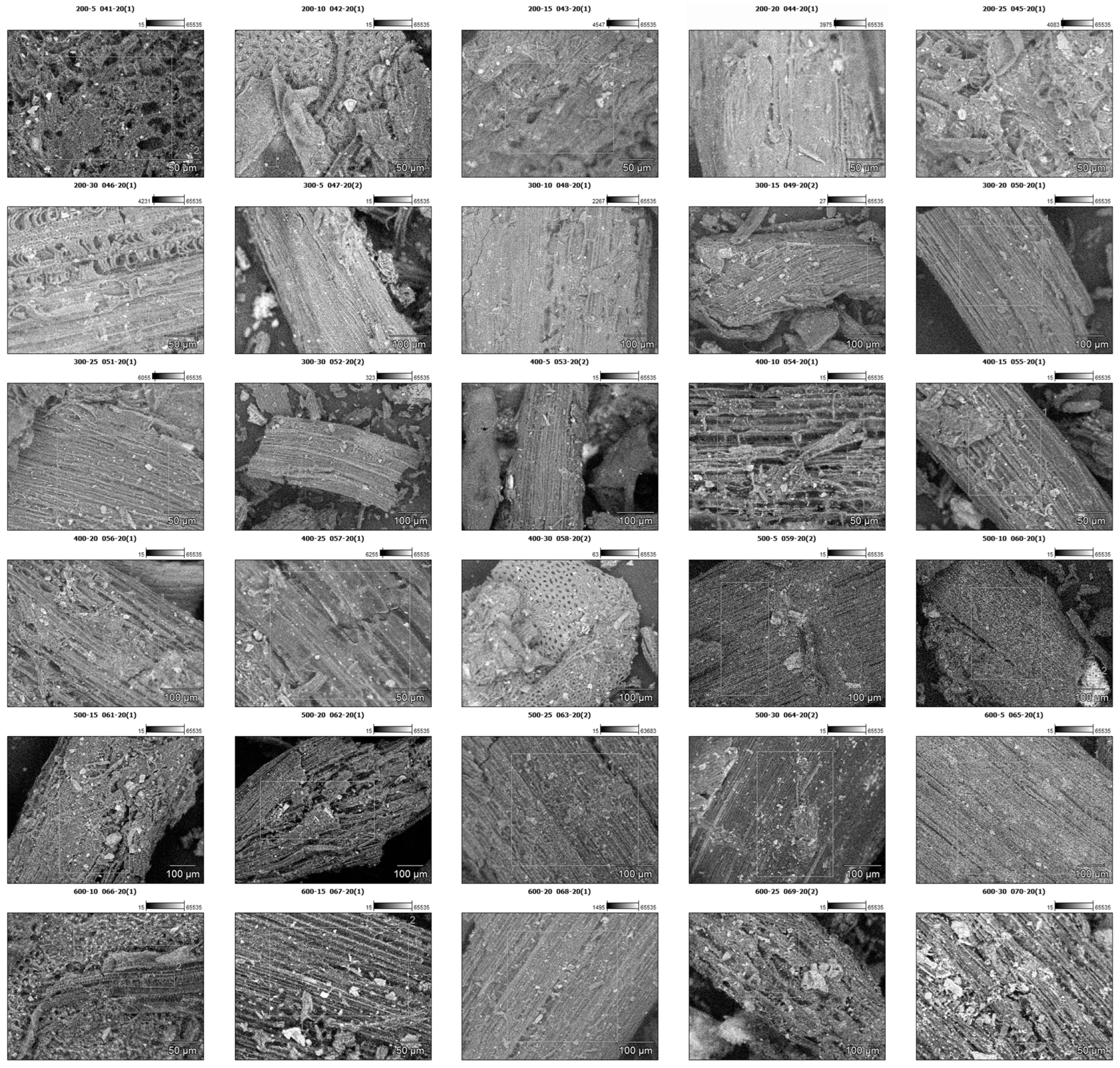
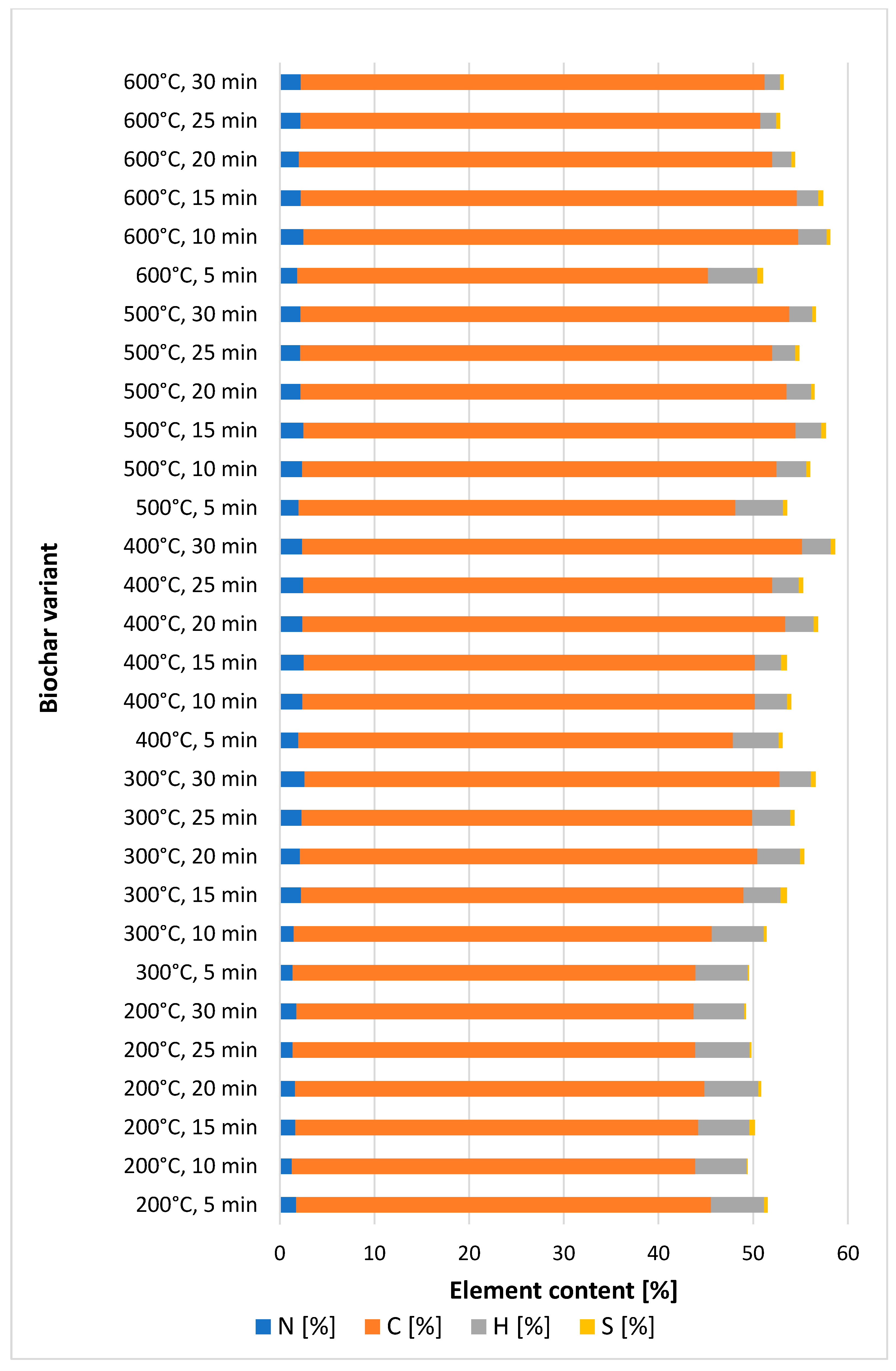

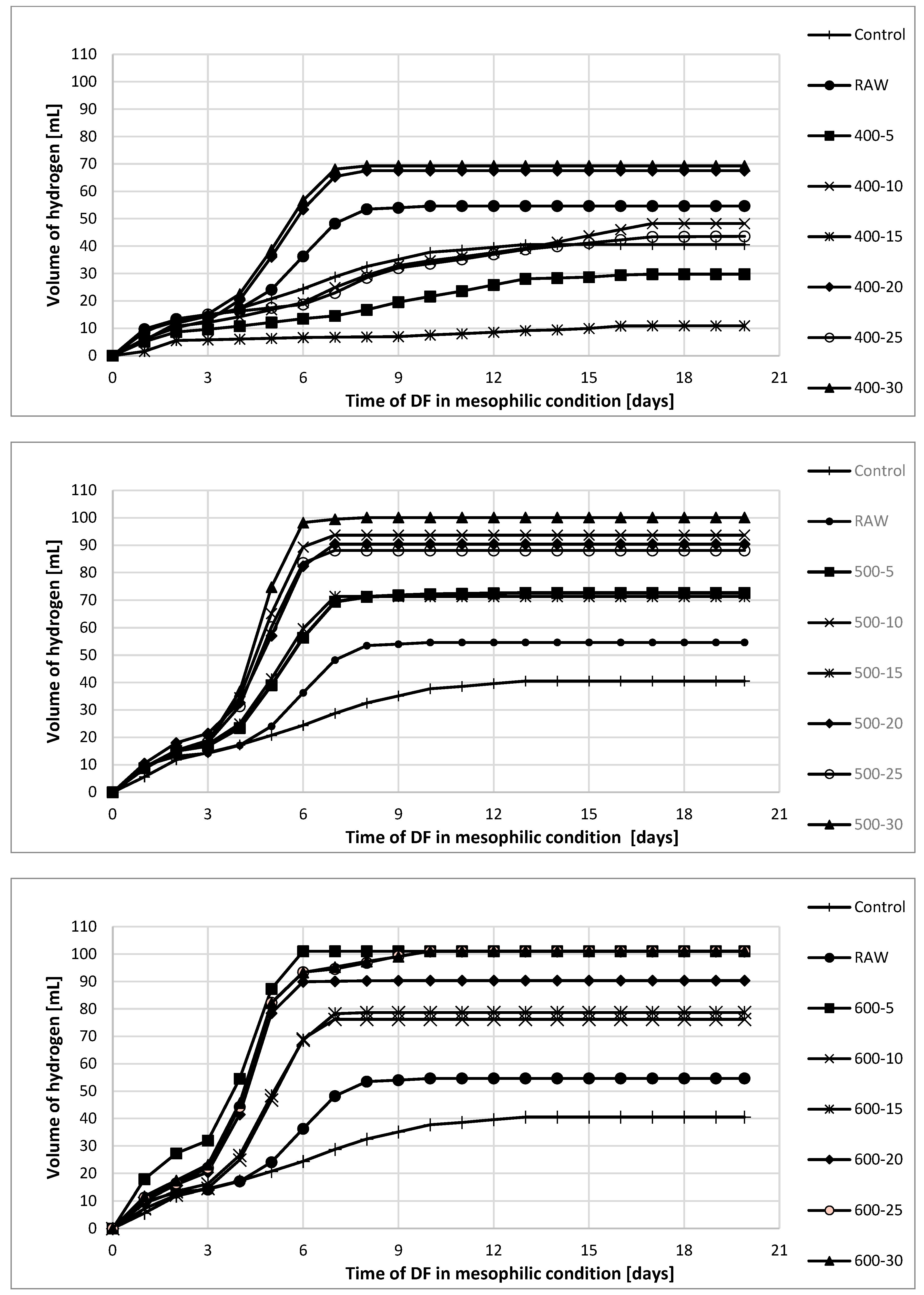
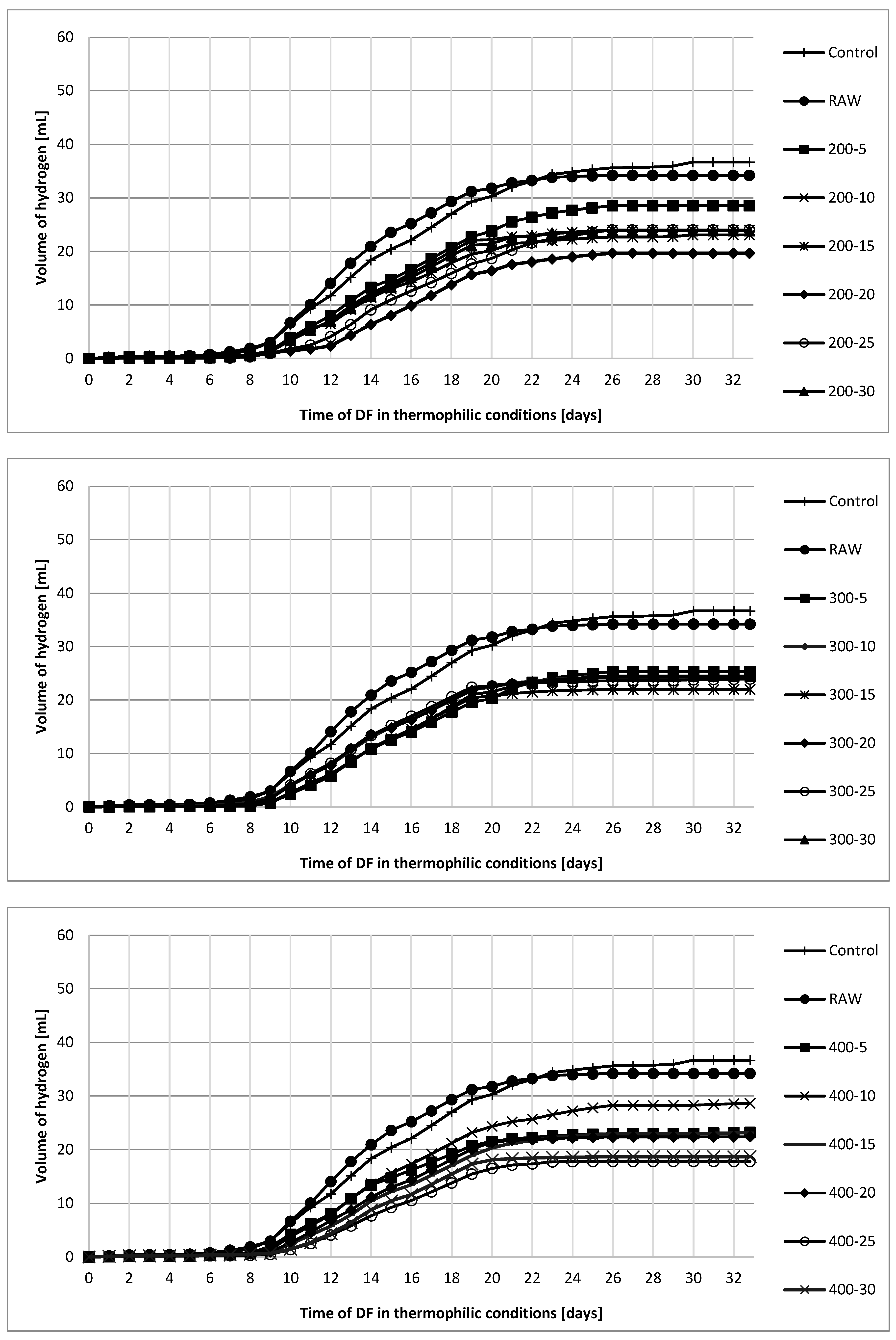
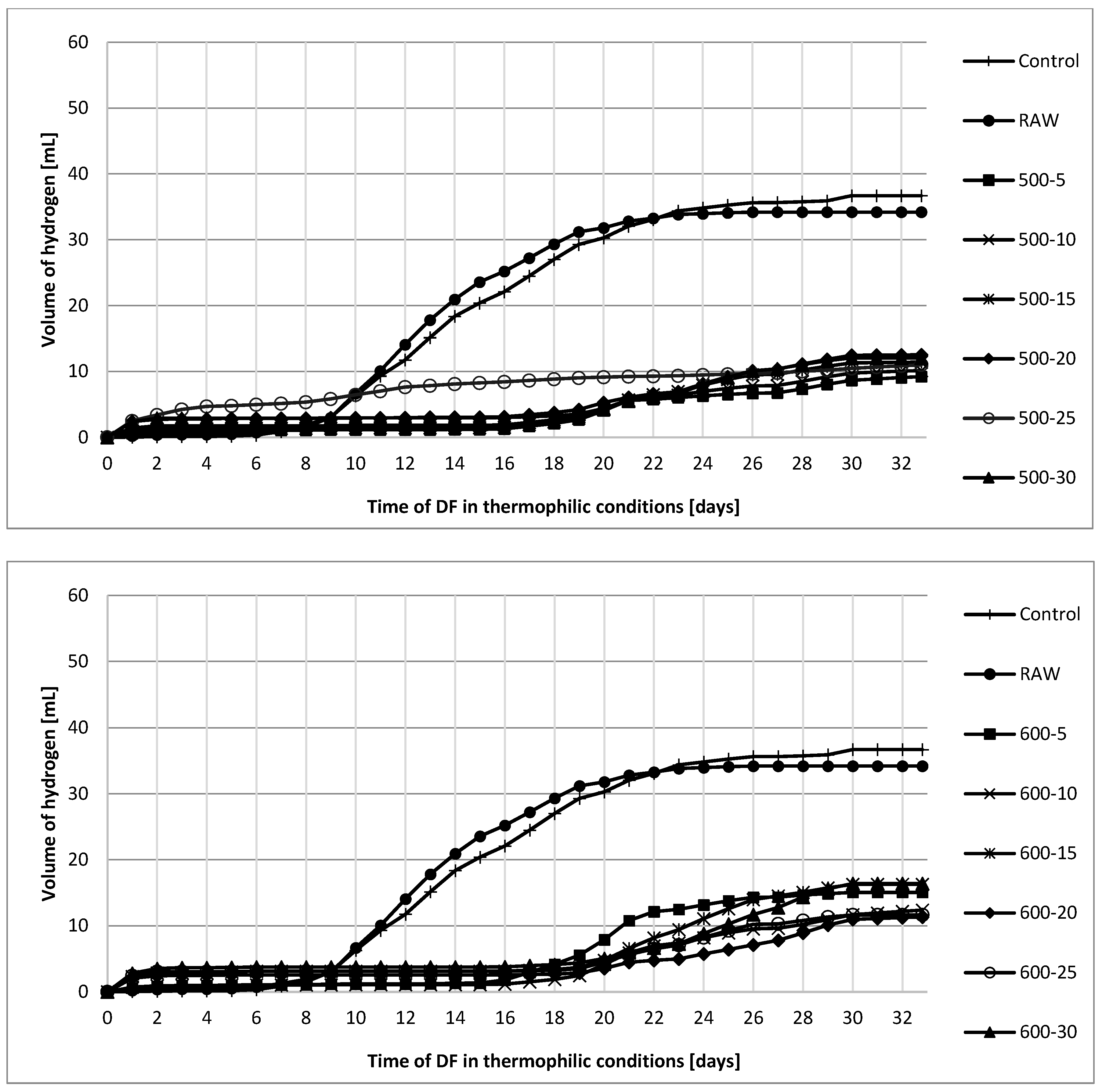
| Parameter | Mesophilic Inoculum | Thermophilic Inoculum | Crystalline Glucose |
|---|---|---|---|
| Dry matter (DM) [% FM] | 4.50 | 4.84 | 91.11 |
| Organic Dry Matter (ODM) [%] | 70.12 | 70.75 | 99.77 |
| DM after acid treatment [%] | 6.58 | 6.34 | - |
| ODM after acid treatment [%] | 69.22 | 68.46 | - |
| pH before acid treatment [−] | 7.68 | 7.72 | - |
| pH during acid treatment [−] | 2.8 | 2.59 | - |
| pH after acid treatment [−] | 5.65 | 5.55 | - |
| Number | Name of Sample | Biochar Production Temperature (°C) | Biochar Holding Time (min) | Moisture (%) | VTS (% TS) |
|---|---|---|---|---|---|
| 1 | Control (RAW) | - | - | 5.06 | 82.67 |
| 2 | 200/5 | 200 | 5 | 5.78 | 84.48 |
| 3 | 200/10 | 200 | 10 | 5.67 | 82.18 |
| 4 | 200/15 | 200 | 15 | 5.40 | 81.96 |
| 5 | 200/20 | 200 | 20 | 5.06 | 82.38 |
| 6 | 200/25 | 200 | 25 | 5.35 | 83.88 |
| 7 | 200/30 | 200 | 30 | 4.99 | 81.80 |
| 8 | 300/5 | 300 | 5 | 5.62 | 82.49 |
| 9 | 300/10 | 300 | 10 | 4.39 | 80.29 |
| 10 | 300/15 | 300 | 15 | 3.85 | 71.12 |
| 11 | 300/20 | 300 | 20 | 3.47 | 72.67 |
| 12 | 300/25 | 300 | 25 | 3.60 | 61.83 |
| 13 | 300/30 | 300 | 30 | 3.71 | 64.21 |
| 14 | 400/5 | 400 | 5 | 4.27 | 79.33 |
| 15 | 400/10 | 400 | 10 | 4.50 | 67.69 |
| 16 | 400/15 | 400 | 15 | 4.37 | 67.21 |
| 17 | 400/20 | 400 | 20 | 4.87 | 66.95 |
| 18 | 400/25 | 400 | 25 | 5.05 | 66.65 |
| 19 | 400/30 | 400 | 30 | 5.34 | 68.38 |
| 20 | 500/5 | 500 | 5 | 4.12 | 74.69 |
| 21 | 500/10 | 500 | 10 | 4.73 | 69.79 |
| 22 | 500/15 | 500 | 15 | 4.92 | 66.53 |
| 23 | 500/20 | 500 | 20 | 5.10 | 66.84 |
| 24 | 500/25 | 500 | 25 | 5.14 | 60.53 |
| 25 | 500/30 | 500 | 30 | 4.56 | 56.97 |
| 26 | 600/5 | 600 | 5 | 4.46 | 79.97 |
| 27 | 600/10 | 600 | 10 | 4.70 | 61.28 |
| 28 | 600/15 | 600 | 15 | 4.39 | 63.25 |
| 29 | 600/20 | 600 | 20 | 4.22 | 54.08 |
| 30 | 600/25 | 600 | 25 | 5.04 | 53.26 |
| 31 | 600/30 | 600 | 30 | 5.43 | 57.31 |
| Name of Sample | DF Mesophilic | DF Thermophilic | ||
|---|---|---|---|---|
| Cumulative Production of H2 (mL H2/gODM Glucose) | Cumulative Production of Biogas (mL/gODM Glucose) | Cumulative Production of H2 (mL H2/gODM Glucose) | Cumulative Production of Biogas (mL/gODM Glucose) | |
| Control | 40.6 | 271.0 | 36.7 | 136.0 |
| RAW | 54.6 | 210.1 | 34.2 | 130.8 |
| 200-5 | 8.5 | 37.9 | 28.5 | 125.4 |
| 200-10 | 13.5 | 55.9 | 24.0 | 111.5 |
| 200-15 | 13.8 | 54.8 | 23.1 | 99.4 |
| 200-20 | 7.1 | 47.6 | 19.7 | 103.3 |
| 200-25 | 14.3 | 64.1 | 24.0 | 106.2 |
| 200-30 | 26.8 | 100.4 | 23.9 | 103.6 |
| 300-5 | 8.6 | 41.0 | 25.3 | 104.2 |
| 300-10 | 21.7 | 82.4 | 24.3 | 109.0 |
| 300-15 | 32.4 | 106.2 | 22.0 | 101.6 |
| 300-20 | 19.7 | 88.5 | 24.4 | 110.4 |
| 300-25 | 34.6 | 113.9 | 23.9 | 99.2 |
| 300-30 | 18.3 | 75.7 | 24.5 | 111.9 |
| 400-5 | 29.7 | 108.0 | 23.2 | 111.7 |
| 400-10 | 48.2 | 147.4 | 28.7 | 123.2 |
| 400-15 | 10.9 | 50.1 | 23.2 | 108.6 |
| 400-20 | 67.6 | 230.6 | 22.4 | 108.8 |
| 400-25 | 43.6 | 128.8 | 17.8 | 95.3 |
| 400-30 | 69.3 | 252.1 | 18.7 | 101.7 |
| 500-5 | 72.6 | 248.5 | 9.2 | 80.8 |
| 500-10 | 93.7 | 290.0 | 10.1 | 85.6 |
| 500-15 | 71.4 | 256.9 | 11.4 | 91.2 |
| 500-20 | 90.4 | 287.5 | 12.5 | 94.5 |
| 500-25 | 88.1 | 282.2 | 11.0 | 162.3 |
| 500-30 | 100.1 | 304.3 | 12.1 | 100.2 |
| 600-5 | 101.0 | 303.0 | 15.1 | 101.4 |
| 600-10 | 76.2 | 253.3 | 12.4 | 90.4 |
| 600-15 | 78.7 | 269.9 | 16.3 | 120.7 |
| 600-20 | 90.3 | 279.9 | 11.3 | 90.6 |
| 600-25 | 101.0 | 334.8 | 11.7 | 94.6 |
| 600-30 | 101.1 | 335.4 | 16.4 | 112.9 |
Disclaimer/Publisher’s Note: The statements, opinions and data contained in all publications are solely those of the individual author(s) and contributor(s) and not of MDPI and/or the editor(s). MDPI and/or the editor(s) disclaim responsibility for any injury to people or property resulting from any ideas, methods, instructions or products referred to in the content. |
© 2023 by the authors. Licensee MDPI, Basel, Switzerland. This article is an open access article distributed under the terms and conditions of the Creative Commons Attribution (CC BY) license (https://creativecommons.org/licenses/by/4.0/).
Share and Cite
Kozłowski, K.; Dach, J.; Czekała, W.; Malińska, K.; Świechowski, K.; Pulka, J.; Lewicki, A. Influence of the Parameters of Used Biochar on the Dark Fermentation Process. Energies 2023, 16, 7484. https://doi.org/10.3390/en16227484
Kozłowski K, Dach J, Czekała W, Malińska K, Świechowski K, Pulka J, Lewicki A. Influence of the Parameters of Used Biochar on the Dark Fermentation Process. Energies. 2023; 16(22):7484. https://doi.org/10.3390/en16227484
Chicago/Turabian StyleKozłowski, Kamil, Jacek Dach, Wojciech Czekała, Krystyna Malińska, Kacper Świechowski, Jakub Pulka, and Andrzej Lewicki. 2023. "Influence of the Parameters of Used Biochar on the Dark Fermentation Process" Energies 16, no. 22: 7484. https://doi.org/10.3390/en16227484
APA StyleKozłowski, K., Dach, J., Czekała, W., Malińska, K., Świechowski, K., Pulka, J., & Lewicki, A. (2023). Influence of the Parameters of Used Biochar on the Dark Fermentation Process. Energies, 16(22), 7484. https://doi.org/10.3390/en16227484










